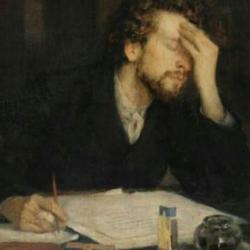Some background notes for a lecture on Melville.
It’s a simplification, but a revealing one, to say that American literature has been dominated by two themes that at times become one theme: God and America. The earliest American literature is devotional, sermonic, hortatory, hagiographic, or a recounting of providential history. Pick up an anthology of American literature, and you start with William Bradford’s pious history of the Plymouth Plantation, John Winthrop’s Journal or his Model of Christian Charity, Cotton Mather’s Magnalia Christi Americana, the Bay Psalm Book, sermons and other religious writing. When we get to what we more narrowly consider “literature,” we find the poems of Anne Bradstreet (1612-72) and Edward Taylor, who are religious poets. They write on many topics, but everything is infused with a religious warmth and zeal, as one would expect from Puritan poets.
For example, Bradstreet’s poem “To My Dear and Loving Husband” is simultaneously a passionate love poem and a meditation on eternity:
If ever two were one, then surely we.
If ever man were loved by wife, then thee;
If ever wife was happy in a man,
Compare with me, ye women, if you can.
I prize thy love more than whole mines of gold
Or all the riches that the East doth hold.
My love is such that rivers cannot quench,
Nor ought but love from thee, give recompense.
Thy love is such I can no way repay,
The heavens reward thee manifold, I pray.
Then while we live, in love let’s so persevere
That when we live no more, we may live ever.
Already with Puritan writers, the twin themes of God and America are intertwined. Both Pilgrim’s and Puritans saw their colonies as experiments in Christian community, and Mather’s Magnalia is a compilation of materials concerning the ecclesiastical history of New England, and the work is designed to show the Providence of God in establishing and guiding the Puritans of Massachusetts Bay Colony.
The writings of the Founders were largely historical and political, but sermons, religious tracts, and other writings were also very common. Jonathan Edwards, for instance, was writing about the Great Awakening a few decades before the outbreak of the War for Independence. But the works that remain important from this period are largely about America and American independence: Thomas Paine’s Common Sense, Jefferson’s Notes on Virginia, the Federalist and Anti-Federalist Papers. Novels were published in the US, but they were often printings of British novels. Susanna Rowson’s Charlotte: A Tale of Truth was published in England in 1791, and in Philadelphia in 1793, and became an American best-seller. It went through more than 160 editions, 42 before 1820. Sir Walter Scott was very popular in the first part of the nineteenth century, particularly in the South.
There were popular American novelists and creative writers during this period. In 1798, Charles Brockden Brown published Wieland, or the Transformation, which has been described as a gothic horror novel, set in Pennsylvania in the 1760s, and he published other novels in the same period. Washington Irving, now best known for his short stories, began publishing in the early 19th century. Though Brown especially was adapting British genres to American settings, the books of these writers were largely about the American experience.
The only early American novelist who is still widely read is James Fenimore Cooper, whose first novels began to appear in the 1820s. Cooper’s novels introduce explicitly the experience of the frontier that deeply shaped American literature and mentality well into the twentieth century. Even as late as the Roaring Twenties, F. Scott Fitzgerald was (arguably) writing about the effects that the end of the pioneer age had on American mores. American historian Frederick Jackson Turner claimed that the American frontier was the key to understanding American history. According to one summary of his 1893 lecture, “The presence and predominance of numerous cultural traits – ‘that coarseness and strength combined with acuteness and acquisitiveness; that practical inventive turn of mind, quick to find expedients; that masterful grasp of material things . . . . that restless, nervous energy; that dominant individualism’ — could all be attributed to the influence of the frontier. Turner’s essay reached triumphalist heights in his belief that the promotion of individualistic democracy was the most important effect of the frontier. Individuals, forced to rely on their own wits and strength, he believed, were simply too scornful of rank to be amenable to the exercise of centralized political power.” So, when I say that America is one of the leading themes of American literature, it is not merely America’s history of colonization, settlement, and independence, but the very physical reality of America and the effect that this has on American life and experience. Think, at a popular level, of the countless Western novels of Zane Gray and Louis L’Amour.
The impact of these twin themes on American literature comes to one of its most robust expressions in what F. O. Matthiessen described as the “American Renaissance.” As Matthiessen describes it in his book of that title, the impetus for the book came from “my realization of how great a number of our past masterpieces were produced in one extraordinarily concentrated moment of expression. It may not seem precisely accurate to refer to our mid-nineteenth century as a re-birth; but that was how the writers themselves judged it. Not as a re-birth of values that had existed previously in America, but as America’s way of producing a renaissance, by coming to its first maturity and affirming its rightful heritage in the whole expanse of art and culture.”
Specifically, Matthiessen is referring to the first half of the 1850s, during which Hawthorne published The Scarlet Letter (1850) and The House of Seven Gables (1851); Melville published Moby-Dick (1851) and Pierre (1852); Thoreau wrote Walden (1854); and Whitman write Leaves of Grass (1855). Though Matthiessen doesn’t discuss it at length, this was also the decade of Longfellow’s Hiawatha, which, despite the ease with which it is mocked and parodies, remains a truly great poem. And many of these books are about the twin themes that I’ve described. Hawthorne’s two books are efforts to exorcise what he considered the personal and national demons of Puritanism. Walden was in part a reaction to America’s shift from an agrarian to an industrial civilization, symbolized by the railroad that came to Thoreau’s hometown of Concord in 1844 and began to transform Concord into a suburb of Boston – though, as Matthiessen points out, the “farmer rather than the businessman was still the average American.” Melville’s interests were more thoroughly cosmic, expressing his agonized search for some certainty about what lies behind the plaster wall of visible reality.
Matthiessen noted that the “concentrated abundance of our mid-nineteenth century” could be examined in the light of the “breakdown of Puritan orthodoxy into Unitarianism, and of the quickening of the cool Unitarian strain into the spiritual and emotional fervor of transcendentalism.” Another factor was the spread and success of American democracy: “The one common denominator of my five writers, uniting even Hawthorne and Whitman, was their devotion to the possibilities of democracy.” All were aiming at some kind of American mythology, and at the creation of distinctively American forms of heroism.















